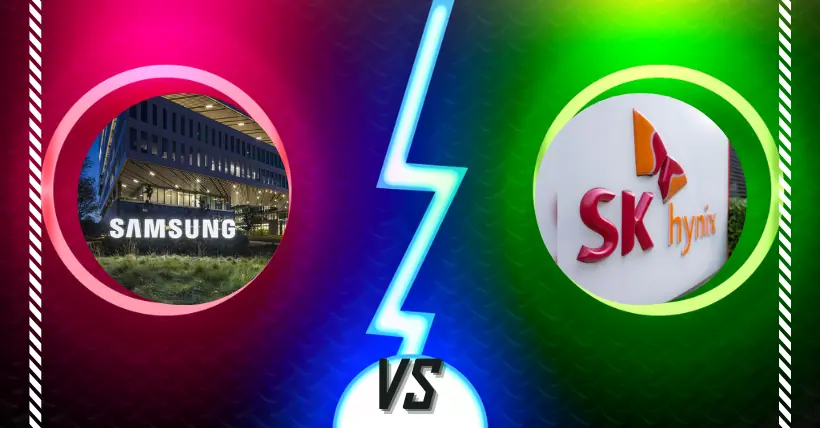Data released by the South Korean Stock Exchange on the 27th shows that the market cap gap between Samsung Electronics and SK Hynix has narrowed to its smallest level in nearly 13 years. As of October 25, Samsung Electronics’ common stock market cap stood at 333.71 trillion won (about 1.7 trillion RMB), accounting for 15.85% of the total market cap of the KOSPI index, its lowest level in over eight years. Meanwhile, SK Hynix’s common stock market cap reached 146.328 trillion won, representing 6.95% of the KOSPI index, a historic high.
Samsung has long been recognized as a vital pillar of South Korea’s economy, topping the global semiconductor ranking in 2022. However, Samsung has faced a series of recent challenges. This article will delve into the growth trajectories of Samsung and SK Hynix, focusing on this fierce semiconductor rivalry in South Korean.
1. Samsung – South Korea’s Legendary Company
Samsung Group’s history began in 1938, when 28-year-old founder Lee Byung-chul started “Samsung Trading Company” in Daegu, initially dealing in trade and brewing. Ten years later, he founded “Samsung C&T Corporation” to expand international trade, generating a profit of 120 million won in just its first year. In 1967, after Samsung went through a business downturn, Lee returned to the company and shifted its focus to the electronics industry. Observing the rise of the electronics sector in developed countries while South Korea remained a “blue ocean,” he decided to enter the field.
Since the 1960s, South Korea has promoted its semiconductor industry aggressively. Partnering with Japanese companies, Lee established production facilities, leading to the founding of Samsung Electronics in 1969. By 1970, Samsung began production. Initially, with limited technological support, Samsung’s research team relied on reverse-engineering products on the market. In 1972, Samsung developed color TVs and exported them to the U.S. Amid rapid economic growth, Samsung also expanded into heavy industry, chemicals, and petrochemicals, guided by Lee’s acute market insight and unwavering determination.
In 1973, Samsung Electro-Mechanics was established as a producer of electronic components, and in 1974, Samsung Group acquired 50% of South Korea Semiconductor. In 1975, South Korea introduced a six-year plan to support the semiconductor industry, promoting domestic production of electronic components. In 1978, Samsung’s semiconductor division spun off as an independent entity. During visits to Japan and the U.S., Lee decided to enter the semiconductor field, despite internal resistance. In 1983, Samsung successfully developed a 64K DRAM, becoming the third company globally, after Japan and the U.S., to achieve this.
With its counter-cyclical investment strategy, Samsung solidified its global position in semiconductors, even amid the 2008 financial crisis, which saw DRAM prices plummet. Samsung once again increased its investment, securing its market dominance. Around this time, SK Hynix began its rise.
2. SK Hynix – The Rising Star
Founded in 1983, SK Hynix initially operated as Hyundai Semiconductor, benefiting from government policies supporting South Korea’s domestic semiconductor industry. In 1985, Hyundai quickly gained technological ground through OEM production with Texas Instruments, achieving rapid progress. In 1986, Hyundai began mass production of 64K DRAM, closing the technological gap with Samsung to just one year. In 1999, Hyundai merged with LG Semiconductor, taking on significant debt, and in 2001 it restructured and rebranded as Hynix. Hynix’s “Blue Chip Project” later helped it recover by repurposing production lines, leading to eventual success.
In 2008, Hynix acquired the U.S.-based Hynix Semiconductor, boosting its technology and market share. SK Group acquired Hynix in 2012, allowing it to break into the DRAM market more competitively.
3. Fierce Rivals in the Same Industry
Looking back, Samsung’s journey has been one of building from the ground up, while Hynix took advantage of strategic partnerships and support to grow. As of 2023, Samsung holds around 43% of the global DRAM market, with SK Hynix at 28%. Samsung remains dominant in consumer electronics, while SK Hynix has found a niche in the data center market, becoming a key supplier for AI leader NVIDIA. Meanwhile, Samsung has faced delays in certification due to technical issues.
As Samsung tightens its focus on high-bandwidth memory (HBM4) and CXL memory technologies, this “semiconductor battle” in South Korean is far from over.

Disclaimer:
- This channel does not make any representations or warranties regarding the availability, accuracy, timeliness, effectiveness, or completeness of any information posted. It hereby disclaims any liability or consequences arising from the use of the information.
- This channel is non-commercial and non-profit. The re-posted content does not signify endorsement of its views or responsibility for its authenticity. It does not intend to constitute any other guidance. This channel is not liable for any inaccuracies or errors in the re-posted or published information, directly or indirectly.
- Some data, materials, text, images, etc., used in this channel are sourced from the internet, and all reposts are duly credited to their sources. If you discover any work that infringes on your intellectual property rights or personal legal interests, please contact us, and we will promptly modify or remove it.



